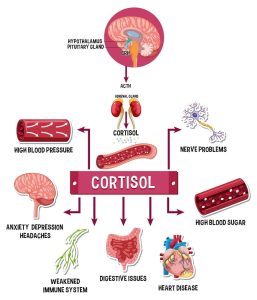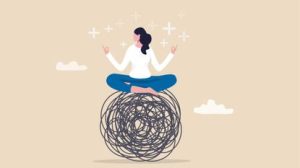Osteopathy and Cortisol: Supporting Your Health
Cortisol is often described as the body’s “stress hormone.” While it has a bad reputation, it is vital for survival. Cortisol helps us wake in the morning, regulates energy, supports immune function, and equips us to respond to daily challenges. The problem arises when cortisol stays elevated for too long, leading to strain on multiple systems in the body.
When Cortisol Stays Too High

Chronically elevation of cortisol, referred to as hypercortisolism, can cause wide-ranging health issues. One of the clearest effects is on bone health. Clinical literature shows that excessive cortisol disrupts bone-building cells, reduces bone strength, and increases fracture risk — and in some cases, this risk remains even after cortisol levels return to normal (Zdrojowy-Wełna et al., 2024).
Elevated cortisol can also contribute to muscle weakness, weight gain around the midsection, high blood pressure, poor sleep, and mood changes. Over time, the immune system may also be suppressed, making people more vulnerable to illness. These effects highlight why strategies that help regulate cortisol are so valuable to maintaining optimal health.
The Role of Osteopathy
 Osteopathic treatment works through the body’s structure to support its natural self-regulating systems. By reducing strain in muscles and joints, improving circulation, and positively influencing the nervous system, osteopathy can affect how the body processes stress.
Osteopathic treatment works through the body’s structure to support its natural self-regulating systems. By reducing strain in muscles and joints, improving circulation, and positively influencing the nervous system, osteopathy can affect how the body processes stress.
A systematic review found that osteopathic treatment was linked to modest reductions in cortisol compared to sham or control interventions (Oviedo & Toldi, 2023). Though the changes were small, the findings suggest that manual therapy may influence stress physiology. Importantly, patients often describe feeling calmer and more at ease after treatment — a reflection of shifts within the autonomic nervous system.
Other studies also suggest that certain osteopathic techniques can affect autonomic activity (Rechberger et al., 2019). Since the nervous system closely governs the stress response, these effects may help reduce the strain of prolonged cortisol elevation.
Everyday Strategies for Cortisol Regulation

Osteopathy can be a useful tool, but it works best alongside daily habits that protect the body from chronic stress. Evidence-based strategies include:
- Prioritising sleep: Cortisol naturally peaks in the morning and falls at night. Poor or irregular sleep disrupts this cycle. Aim for consistent sleep and wake times, and limit light exposure before bed.
- Relaxation practices: Simple exercises such as slow breathing, meditation, or mindfulness exercisesreduce sympathetic nervous system activity and can ease cortisol release. Just a few minutes daily can have measurable effects.
- Move consistently: Regular, moderate activity such as walking, yoga, or swimming supports healthy cortisol rhythms. Over-exercising, however, may push levels higher.
- Eat for stability: Irregular meals and excess processed sugar cause spikes in blood sugar, which can drive cortisol higher. Choosing whole foods and balanced meals helps maintain steadier hormone patterns.
- Foster connection and self-compassion: Social support and positive relationships reduce the impact of stress. Research also shows that self-compassion is linked to healthier cortisol patterns and lower perceived stress (Cowand et al., 2024).
Looking Ahead

Cortisol itself is not harmful — it plays a central role in keeping us alert, energised, and resilient. The challenge comes when life’s pressures keep cortisol elevated beyond what the body can adapt to. Research into osteopathy shows early evidence that OMT can influence cortisol levels, most likely through its effects on the nervous system and stress response (Oviedo & Toldi, 2023; Rechberger et al., 2019).
When combined with consistent lifestyle practices such as restorative sleep, regular movement, effective stress-management tools, and supportive social connections, osteopathy offers a practical way of easing the physiological load of stress. By addressing both the physical and hormonal effects, this approach can support stronger bones, steadier energy, and improved wellbeing.
References
Cowand, A., Boduszek, D., Willmott, D., Denovan, A., & Moore, G. (2024). The association between self-compassion, stress, and diurnal cortisol. Stress, 27(1), 1–9. https://doi.org/10.1080/
Oviedo, D., & Toldi, J. (2023). Osteopathic manipulation as a method of cortisol modification: A systematic review. Cureus, 15(3), e35859. https://doi.org/10.
Rechberger, V., Biberschick, M., & Porthun, J. (2019). Effectiveness of osteopathic interventions in the treatment of autonomic nervous system disorders: A systematic review of the literature. International Journal of Osteopathic Medicine, 31, 3–10. https://doi.org/10.
Zdrojowy-Wełna, A., Gierek, T., Puzianowska-Kuźnicka, M., & Zieliński, G. (2024). Bone health in endogenous hypercortisolism: From molecular insights to clinical practice. Pituitary, 27, 377–386. https://doi.org/